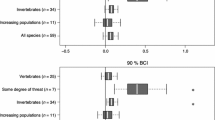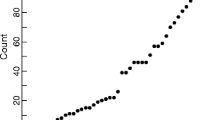Abstract
The challenge of conservation biology is to make models that predict population dynamics and have a high probability of accurately tracking population change (increase, decrease, constancy). In this study we tested whether the transition model is accurate enough to predict population persistence and size 13 years down and whether after 13 years populations had achieved a stable stage distribution. We modeled 6 small populations of an epiphytic orchid using a Lefkovitch type analysis to predict population growth pattern based on monthly surveys for approximately 1.5 years. In addition, sensitivity and elasticity analyses were used to identify life stages with high sensitivity or elasticity that have the largest influence on population growth rate. We re-censused the populations 13 years after the first study and compared the structure of the populations to predictions based on the earlier census data. Effective population growth rates were similar to those expected except for one where the population went extinct. The prediction slightly (but not significantly) overestimated the actual population growth rates of some populations. Elasticity analysis revealed that the adult stage is critical in the life cycle. The observed stage distributions of the populations were not stable at the beginning of the survey and neither were they after 13 years. We suggest that this might be caused by external perturbations that result in unequal mortality between life stages and stochastic recruitment events. The ability of the matrices to predict population size approximately eight generations in the future is encouraging and warrants the continued use of these approaches for PVA.


Similar content being viewed by others
References
Ackerman JD (1995) An orchid flora of Puerto Rico and the Virgin islands. Mem NY Bot Gard 73:1–208
Arditti J, Clements MA, Fast G, Hadley G, Nishimura G, Ernst R (1982) Orchid seed germination and seedling culture. In: Arditti J (ed) Orchid biology, review and perspectives 2. Cornell University Press, Ithaca, New York
Barré N, Feldmann P (1991) Orchidées sauvage des Petites Antilles. II. Le genre Lepanthes Swartz en Guadeloupe: identification, status et repartition. L’Orchidophile 95:4–9
Beissinger SR, Westphal MI (1998) On the use of demographic models of population viability in endangered species management. J Wildl Manag 62:821–841
Bierzychudek P (1999) Looking backwards: assessing the projections of a transition matrix model. Ecol Appl 9:1278–1287
Boyce MS, Haridas CV, Lee CT, NCEAS Stochastic Demography Working Group (2006) Demography in an increasingly variable world. Trends Ecol Evol 21:141–148
Brault S, Caswell H (1993) Pod-specific demography of killer whales (Orcinus orca). Ecology 74:1444–1454
Burgman MA, Ferson S, Akçakaya HR (1993) Risk assessment in conservation biology. Chapman and Hall, New York, USA
Caswell H (1978) A general formula for the sensitivity of population growth rate to changes in life history parameters. Theor Popul Biol 14:215–230
Caswell H (1989) Matrix population models: construction, analysis and interpretation. Sinauer Associates, Inc. Publishers, Sunderland, USA
Caswell H (2000) Prospective and retrospective perturbation analyses: their roles in conservation biology. Ecology 81:619–627
Caswell H (2001) Matrix population models: construction, analysis and interpretation, 2nd edn. Sinauer Associates, Inc Publishers, Sunderland, USA
Caswell H (2007) Sensitivity analysis of transient population dynamics. Ecol Lett 10:1–15
Caswell H, Werner PA (1978) Transient behavior and life history analysis of teasel (Dipsacus sylvestris Huds.). Ecology 59:53–66
de Kroon H, Plaiser A, van Groenendael J, Caswell H (1986) Elasticity: the relative contribution of demographic parameters to population growth rate. Ecology 67:1427–1431
Doak DF, Gross K, Morris WF (2005a) Understanding and predicting the effects of sparse data on demographic analyses. Ecology 86:1154–1163
Doak DF, Morris WF, Pfister C, Kendall BE, Bruna EM (2005b) Correctly estimating how environmental stochasticity influences fitness and population growth. Am Nat 166:E14–E21
Doak DF, Estes JA, Halpern BS, Jacob U, Lindberg DR, Lovvorn J, Monson DH, Tinker TM, Williams TM, Wootton JT, Carroll I, Emmerson M, Micheli F, Novak M (2008) Understanding and predicting ecological dynamics: are major surprises inevitable? Ecology 89:952–961
Ebert TA (1999) Plant and animal populations: methods in demography. Academic Press, San Diego
Fisher M, Matthies D (1998) Effects of population size on performance in the rare plant Gentianella germanica. J Ecol 86:195–204
Gómez NR, Tremblay RL, Meléndez-Ackerman E (2006) Distribution of life cycle stages in a lithophytic and epiphytic orchid. Folia Geobot 41:107–120
Goodman D (1987) The demography of chance extinction. In: Soulé ME (ed) Viable populations for conservation. Cambridge University Press, Cambridge, pp 11–34
Haridas CV, Tuljapurkar S (2007) Time, transients and elasticity. Ecol Lett 10:1143–1153
Hernández-Apolinar M (1992) Dinámica poblacional de Laelia speciosa (H. B. K.) Schltr. (Orchidaceae). Tesis de Licenciatura. Universidad Autónoma de México, Mexico
Hespenheide HA (1968) A revision of West Indian species of Lepanthes: I Jamaica. Proc Acad Nat Sci Phila 120:1–23
Hespenheide HA (1969) A new Lepanthes (Orchidaceae) from Jamaica. Notulae Naturae. Proc Acad Nat Sci Phila 426:1–3
Hespenheide HA (1973) A revision of West Indian species of Lepanthes (Orchidaceae): III Cuba. Brittonia 25:257–283
Hespenheide HA, Dod DD (1989) El género Lepanthes de la Espanola. I. Moscosoa 5:250–264
Hespenheide HA, Dod DD (1990) El género Lepanthes de la Espanola. II. Moscosoa 6:167–195
Hespenheide HA, Dod DD (1993) El género Lepanthes de la Espanola. III. Moscosoa 7:171–198
Horvitz CC, Schemske DW (1995) Spatiotemporal variation in demographic transitions of a tropical understory herb: projection matrix analysis. Ecol Monogr 65:155–192
Hutchings MJ (1991) Monitoring plant populations: census as an aid to conservation. In: Goldsmith FB (ed) Monitoring for conservation and ecology. Chapman and Hall, London, pp 61–76
Jacquemyn H, Brys R, Honnay O (2009) Large population size mitigate negative effects of variable weather conditions on fruit set in two spring woodland orchids. Biol Lett 5:495–498
Luer CA (1986) Icones Pleurothallidinarum I. Systematics of the Pleurothallidinea Orchidaceae. Monogr Syst Bot Mo Bot Gard 15, St. Louis
Marrero-Gómez MV, Oostermejier JGB, Carque-Alamo E, Banares-Baudet A (2007) Population viability of the narrow endemic Helianthenum juliae (Cistaceae) in relation to climate variability. Biol Conserv 136:552–562
Menges ES (1991) The application of minimum viable population theory to plants. In: Falk DA, Holsinger KE (eds) Genetics and conservation of rare plants. Oxford University Press, New York, pp 450–461
Menges ES (1998) Evaluation extinction risks in plant populations. In: Fiedler PL, Jain SK (eds) Conservation biology for the coming decade. Chapman and Hall, New York, pp 49–65
Mondragón D, Durán R, Ramírez I, Valverde T (2004) Temporal variation in the demography of the clonal epiphyte Tillandsia brachycaulos (Bromeliaceae) in the Yucatán Peninsula, Mexico. J Trop Ecol 20:189–200
Morris WF, Doak DF (2002) Quantitative conservation biology: theory and practice of population viability analysis. Sinauer Associates, Inc. Publishers, Sunderland, USA
Silvertown J, Franco M, Pisanthy I, Mendoza A (1993) Comparative plant demography—relative importance of life-cycle components to the finite rate of increase in woody and herbaceous perennials. J Ecol 81:465–476
Stimson WR (1969) A revision of the Puerto Rican species Lepanthes (Orchidaceae). Brittonia 21:332–345
Tremblay RL (1997a) Distribution and dispersion patterns of individuals in nine species of Lepanthes (Orchidaceae). Biotropica 29:38–45
Tremblay RL (1997b) Lepanthes caritensis, an endangered orchid: no sex, no future? Selbyana 18:160–166
Tremblay RL (2000) Plant longevity in four species of Lepanthes (Pleurothallidinae; Orchidcaceae). Lindleyana 15:257–266
Tremblay RL, Ackerman JD (1993) A new species of Lepanthes from Puerto Rico. Brittonia 45:339–342
Tremblay RL, Hutchings MJ (2003) Population dynamics in orchid conservation: a review of analytical methods, based on the rare species Lepanthes eltoroensis. In: Dixon K, Kell S, Barrett R, Cribb P (eds) Orchid conservation. Natural History Publications (Borneo), Kota Kinabalu, Sabah, Malaysia, pp 183–204
Tuljapurkar S (1982) Population dynamics in variable environment. III. Evolutionary dynamics of r-selection. Theor Popul Biol 21:141–165
Tuljapurkar S, Horvitz CC, Pascarella JB (2003) The many growth rates and elasticities of population in random environments. Am Nat 162:489–502
Valverde PL, Zavala-Hurtado JA (2006) Assessing the ecological statys of Mammillaria pectinifera Weber (Cactaceae), a rare and threatened species endemic of the Tehuacan-Cuicatlan Region in central Mexico. J Arid Environ 64:193–208
Winkler M, Hülber K, Hietz P (2007) Population dynamics of epiphytic bromeliads: life strategies and the role of host branches. Basic Appl Ecol 8:183–196
Zotz G (2005) Differences in vital demographic rates in three populations of the epiphytic bromeliad, Werauhia sanguinolenta. Acta Oecol 28:306–312
Zotz G, Laube S, Schmidt G (2005) Long-term population dynamics of the epiphytic bromeliad, Werauhia sanguinolenta. Ecography 28:806–814
Acknowledgments
IS and PK were supported by grants No. LC06073 of the Czech Ministry of Education and AV0Z60870520 of the CAS. RLT was partially supported by Crest-Catec HRD 0206200.
Author information
Authors and Affiliations
Corresponding author
Rights and permissions
About this article
Cite this article
Schödelbauerová, I., Tremblay, R.L. & Kindlmann, P. Prediction vs. reality: Can a PVA model predict population persistence 13 years later?. Biodivers Conserv 19, 637–650 (2010). https://doi.org/10.1007/s10531-009-9724-1
Received:
Accepted:
Published:
Issue Date:
DOI: https://doi.org/10.1007/s10531-009-9724-1




